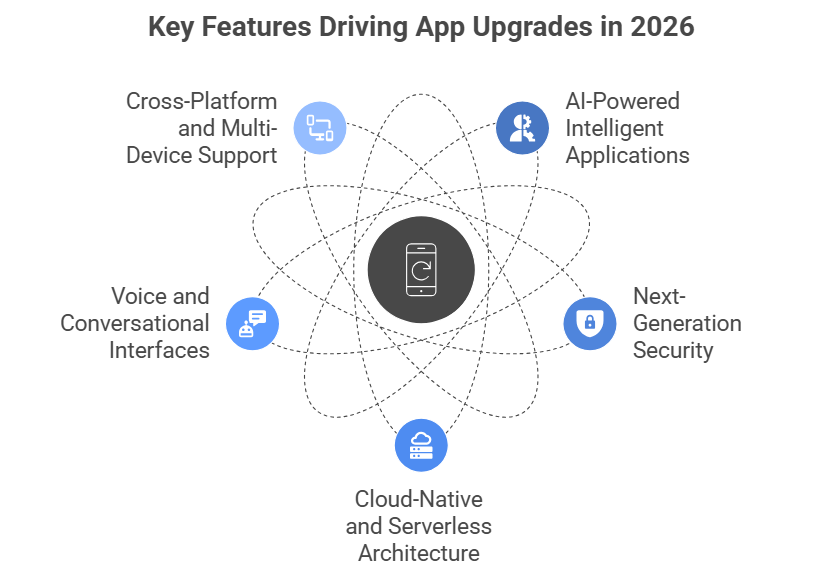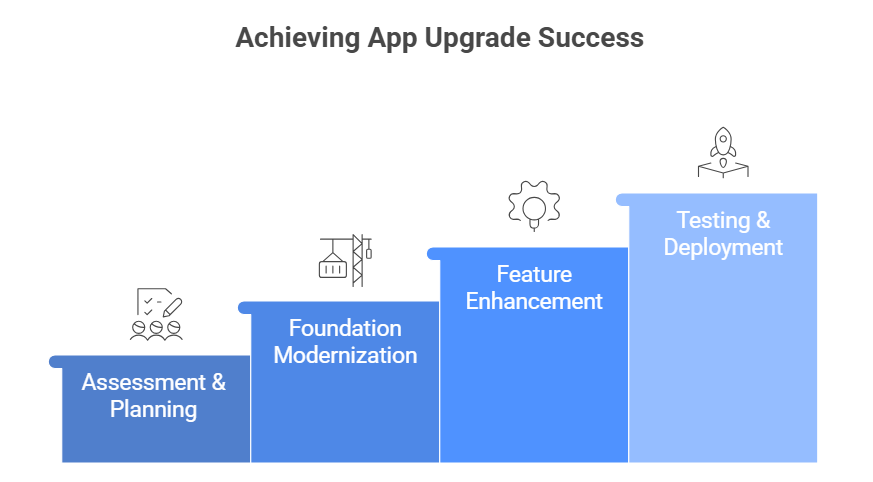Upgrade Your App for 2026: Expert Strategies for Integrating the Latest Features and Tech
As we approach 2026, staying ahead of the technological curve is no longer a luxury but a necessity. For CTOs, app developers, and business leaders, ensuring that your mobile app evolves with the latest trends and innovations is key to remaining competitive. But how can you make sure your app stays relevant in an ever-evolving digital landscape? The answer lies in integrating the latest app features and technologies.
In this post, we’ll explore expert strategies for upgrading your app to meet the demands of the coming year. From incorporating cutting-edge technologies like machine learning to refining user experiences with the latest mobile app features, we’ll cover everything you need to know to ensure your app thrives in 2026.
Why Should You Upgrade Your App for 2026?

Upgrading your mobile app for 2026 is crucial to staying competitive in a fast-evolving landscape. Regular updates help improve security, enhance user experience, and incorporate the latest technologies. Failing to upgrade your app can lead to poor user retention, performance issues, and missed opportunities.
- Improve app performance and user engagement.
- Enhance security with modern encryption and authentication methods.
- Incorporate the latest mobile app technologies to stay ahead of competitors.
The Cost of Inaction: Risks of Not Updating Your App
Delaying app upgrades may seem convenient at first, but it can lead to serious problems over time:
- Security Vulnerabilities and Compliance Risks
Old apps are more prone to security breaches and may no longer meet compliance standards. This can put sensitive data at risk and damage your organization’s reputation. - Declining Performance and User Engagement
Outdated apps often run slowly, crash frequently, or fail to deliver a smooth user experience. This frustrates users and employees, lowering engagement and productivity. - Rising Maintenance Costs and Technical Debt
Apps are expensive to maintain. Over time, the effort required to fix issues and keep the system running grows, making operations less efficient and more costly.
Key Features Driving App Upgrades in 2026
In 2026, modern apps must be adaptive, intelligent, and engaging. Here are key features to consider:

AI-Powered Intelligent Applications
- Machine Learning for Personalization: Analyze user behavior to provide customized content, notifications, and recommendations.
- Predictive Analytics: Anticipate user needs to boost engagement and retention.
Next-Generation Security
- Zero-Trust Architecture: Verify every user and device before granting access.
- Advanced Threat Detection: AI-powered monitoring identifies and mitigates risks in real-time.
- Privacy-First Design: Encryption, anonymization, and transparent policies ensure compliance and trust.
Cloud-Native and Serverless Architecture
- Serverless Computing: Offers scalable, cost-efficient infrastructure with faster feature deployment.
- Microservices & API-First Design: Modular development for flexibility and risk reduction.
- Edge Computing: Improves speed, reduces latency, and supports IoT or AR applications.
Voice and Conversational Interfaces
- Voice UI: Enables interactive workflows and personalized recommendations through natural voice commands.
Cross-Platform and Multi-Device Support
- Unified Frameworks: Tools like Flutter or React Native reduce costs and speed up deployment.
- Responsive Design: Adaptive UI ensures consistent experience across devices.
- IoT & Wearables Integration: Delivers real-time, personalized experiences for connected devices.
Technologies Powering Modern Mobile Apps
Artificial Intelligence & Machine Learning
Advanced Analytics & Business Intelligence
Cloud tools have redefined how teams collaborate, enabling real-time document sharing, video conferencing, and project management, all accessible from any location.
5G Connectivity
Faster networks mean HD streaming, real-time collaboration, and instant data synchronization, critical for apps with heavy user interaction.
Blockchain & Secure Transactions
Blockchain ensures secure transactions, immutable audit trails, and decentralized identity management, perfect for fintech, supply chain, and enterprise apps.
Implementation Roadmap for App Upgrades

Phase 1: Assessment & Planning
- Evaluate technical debt, security gaps, and current architecture.
- Define business KPIs and goals.
- Select the right technology stack for scalability and performance.
Phase 2: Foundation Modernization
- Implement security upgrades and compliance frameworks.
- Migrate to cloud-native or serverless infrastructure.
- Develop and integrate modern APIs for seamless connectivity.
Phase 3: Feature Enhancement & AI Integration
- Introduce ML-driven personalization, predictive analytics, and voice interfaces.
- Redesign UI/UX for multi-device compatibility.
- Add advanced functionalities like AR, IoT, and cross-platform capabilities.
Phase 4: Testing, Deployment & Optimization
- Conduct comprehensive QA and automated testing.
- Deploy in phases with blue-green or feature flag strategies.
- Monitor performance, user behavior, and continuously optimize.
Challenges and Solutions in Mobile App Modernization
Modernizing apps comes with challenges. Integrating old systems requires careful planning to keep data consistent. Skill gaps can slow progress, but at App Maisters, we provide the expertise and resources to handle these complexities efficiently. Ensuring user adoption is also critical, and we guide organizations through clear communication, phased rollouts, and hands-on training to make the transition seamless.
App Maisters Approach to 2026 App Upgrades
App Maisters takes a business-focused approach to app modernization, prioritizing both value and user experience. The process begins with discovery and assessment to identify technical gaps and create a clear upgrade roadmap. Security is built into every step, with zero-trust frameworks, advanced threat detection, and compliance monitoring to protect sensitive data.
Beyond upgrades, the approach includes performance optimization, seamless integration with existing systems, and intuitive user interface improvements. Dedicated teams provide ongoing support, proactive maintenance, and regular updates to ensure apps remain reliable, scalable, and future-ready in the fast-changing digital landscape.
FAQs
Why should I modernize my app now instead of later?
Upgrading your app helps fix security gaps, reduce technical debt, and boost performance. With App Maisters, you get a modern, scalable roadmap so you’re not constantly playing catch‑up.
What are the must-have technologies for a 2026-ready app?
In 2026, apps should leverage AI/ML for personalization, zero‑trust security, serverless or cloud-native architecture, and cross-platform support via frameworks like Flutter or React Native.
How can App Maisters help integrate artificial intelligence into my app?
We assess your data maturity, then build and deploy ML models (or on-device AI) that personalize content, predict user behavior, and improve engagement all while keeping governance and compliance front and center.
What security risks am I exposed to if I don’t modernize my app?
Older apps are more vulnerable to attacks, may not comply with current regulations, and lack AI-driven threat detection. App Maisters helps embed predictive security like zero-trust and real-time threat monitoring into your architecture.
How do I know whether to use microservices, serverless, or a monolith?
It depends on your scale, team, and risk tolerance. App Maisters evaluates your current setup and recommends an architecture. We may favor microservices or serverless to boost agility and scalability.
What’s a realistic roadmap to upgrade my app with App Maisters?
We break modernization into phases: assess current systems, migrate to cloud-native or serverless, add AI-driven features (personalization, voice UI), and then test/optimize with feature‑flag deployment and continuous monitoring.




















